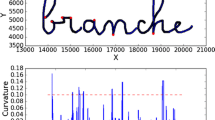Abstract
Two aspects concerning the production of shapes in handwriting are distinguished in the present paper. The first aspect is indicated by thespatial variability of letters measured across replications. Spatial variability is assumed to reflect the basic spatial noise observed in everyday writing. The second aspect deals with the geometric characteristics of letter shapes, measured by the ratio of the vertical over the horizontal letter size (Y/X-ratio). The main question is whether the geometric characteristics and basic spatial noise originate from a common source. More specifically, we are interested in whether Y/X-ratio as well as spatial variability will alter across changed circumstances, or whether Y/X-ratio will alter without a change in spatial variability. Subjects wrote the simple letter sequencelelele in conditions with and without vision under three scaling conditions requirements (small, normal and large letter sizes). The main results were that geometric aspects of letters altered (Y/X-ratio) under no vision and under the scaling requirement to write in a small format. In contrast, shapes were produced with unchanged spatial variability in all conditions of vision and scaling requirements. The results suggest that alterations of geometric aspects of letters across changed circumstances do not necessarily involve an increase in spatial variability.
Similar content being viewed by others
References
Clark, F. J. & Horch, K. W. (1986). Kinesthesia. In: K. B. Boff, L. Kaufman & J. B. Thomas (eds.),Handbook of perception and human performance, Vol. 1:Sensory processes and performance (Chap. 13). New York: Wiley.
Flash, T. & Hogan, N. (1985). The coordination of arm movements: An experimentally confirmed mathematical model,Journal of Neuroscience 5: 1688–1703.
Glencross, D. J. (1980). Levels and strategies of response organisation. In: G. E. Stelmach & J. Requin (eds.),Tutorials in motor behavior (pp. 551–566). Amsterdam: North Holland.
Heuer, H. (1988). Testing the invariance of relative timing: Comment on Gentner (1987),Psychological Review 95: 255–276.
Keele, S. W. (1981). Behavioral analysis of movement. In: V. Brooks (ed.),Handbook of physiology: The nervous system, Vol. 2:Motor control, Part 1 (pp. 1391–1441). Bethesda, MD: American Physiological Society.
Keele, S. W. (1986). Motor control. In: K. B. Boff, L. Kaufman & J. B. Thomas (eds.),Handbook of perception and human performance, Vol. 2:Cognitive processes and performance (Chap. 30). New York: Wiley.
Maarse, F. J., Van Galen, G. P. & Thomassen, A. J. W. M. (1989). Models for the generation of writing units in handwriting under variation of size, slant, and orientation,Human Movement Science 8: 271–288.
Merton, P. A. (1973). How we control contractions of our muscles,Scientific American 226: 30–37.
Morasso, P. (1986). Trajectory formation. In: P. Morasso & V. Tagliasco (eds.),Human movement understanding. Amsterdam: North Holland.
Phillips, J. & Glencross, D. (1985). The independence of reaction and movement time in programmed movements,Acta Psychologica 60: 209–225.
Rosenbaum, D. A. (1991).Human motor control. New York: Academic Press.
Smyth, M. M. & Silvers J. (1987). Functions of vision in the control of handwriting,Acta Psychologica 65: 65–73.
Thomassen, A. J. W. M. & Teulings, H-L. (1985). Time, size and shape in handwriting: Exploring spatio-temporal relationships at different levels. In: J. A. Michon & J. L. Jackson (eds.),Time mind and behaviour. Berlin: Springer.
Thomassen, A. J. W. M. & Teulings, H-L. (1988). Grafische produktie: De motoriek van schrijven en tekenen. In: P. J. G. Keuss, G. ten Hoopen & A. A. J. Mannaerts (eds.),Menselijke motoriek (pp. 43–70). Amsterdam: Swets & Zeitlinger.
Teulings, H-L. & Maarse, F. J. (1984). Digital recording and processing of handwriting movements,Human Movement Science 3: 193–197.
Teulings, H-L. & Schomaker, L. R. B. (1991). Invariant properties of handwriting motor programs to be employed in automatic cursive script recognition. In: G. E. Stelmach (ed.),Proceedings of the 5th IGS Conference on motor control of handwriting (pp. 21–23). Tempe, AZ: Arizona State University.
Teulings, H-L., Thomassen, A. J. W. M. & Van Galen, G. P. (1986). Invariants in handwriting: the information contained in a motor program. In: H. S. R. Kao, G. P. van Galen & R. Hoosain (eds.),Graphonomics: Contemporary research in handwriting (pp. 305–315). Amsterdam: Elsevier.
Van Doorn, R. R. A. & Keuss, P. J. G. (1993). Does the production of strokes in handwriting benefit from vision?,Acta Psychologica 82: 275–290.
Van Doorn, R. R. A. & Keuss, P. J. G. (1992). The role of vision in the temporal and spatial control of handwriting,Acta Psychologica 81: 269–286.
Van Galen, G. P. & Teulings H-L. (1983). The independent monitoring of form and scale factors in handwriting,Acta Psychologica 54: 9–22.
Van Galen, G. P. (1991). Handwriting: Issues for a psychomotor theory,Human Movement Science 10: 165–191.
Wann, J. P. & Nimmo-Smith, I. (1990). Evidence against the relative invariance of timing in handwriting,The Quarterly Journal of Experimental Psychology 42A(1): 105–119.
Wing, A. M. (1978). Response timing in handwriting. In: G. E. Stelmach (ed.),Information processing in motor control and learning (pp. 153–172). London: Academic Press.
Wright, C. E. (1991). Temporal invariance in writing. In: G. E. Stelmach (ed.),Proceedings of the 5th IGS Conference on motor control of handwriting (pp. 86–89). Tempe, AZ: Arizona State University.
Author information
Authors and Affiliations
Rights and permissions
About this article
Cite this article
van Doorn, R.R.A., Keuss, P.J.G. Spatial invariance of handwriting. Read Writ 5, 281–296 (1993). https://doi.org/10.1007/BF01027392
Issue Date:
DOI: https://doi.org/10.1007/BF01027392




